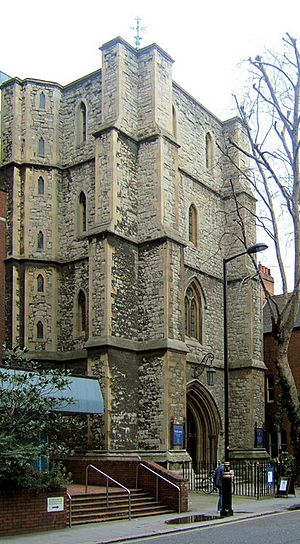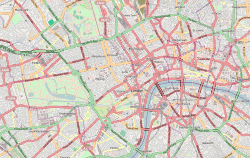St Matthew's Church, Westminster facts for kids
Quick facts for kids St Matthew's Church, Westminster |
|
|---|---|
 |
|
| 51°29′49″N 0°7′51″W / 51.49694°N 0.13083°W | |
| Location | Great Peter Street London SW1P 2BU |
| Country | United Kingdom |
| Denomination | Church of England |
| Churchmanship | Anglo-Catholic |
| Website | www.stmw.org |
| History | |
| Dedication | Matthew the Apostle |
| Architecture | |
| Architect(s) | George Gilbert Scott |
| Style | Gothic Revival |
| Years built | 1849–1851 |
| Specifications | |
| Materials | Kentish ragstone, Bath stone dressings |
| Administration | |
| Deanery | Westminster (St Margaret) |
| Diocese | London |
St Matthew's Church, Westminster, is an Anglican church in Westminster, London. It is located in the heart of London, very close to the Houses of Parliament and Westminster Abbey.
St Matthew's has been important in bringing back older traditions to the Church of England. This movement is called Anglo-Catholicism. A key leader of this movement, Frank Weston, who was the Bishop of Zanzibar, worked at St Matthew's from 1916 to 1918.
Contents
History of St Matthew's Church
Building the Church: 1849-1851
St Matthew's was built between 1849 and 1851. The main architect was Sir George Gilbert Scott. His brother-in-law, George Frederick Bodley, also helped with the design. Scott's son, John Oldrid Scott, designed the building where the church clergy (priests) live.
Later, Sir Ninian Comper added the Lady chapel, which is a special chapel often dedicated to the Virgin Mary. The inside of the church was made more beautiful by the work of Bodley, Charles Kempe, Walter Ernest Tower, and Martin Travers. These artists often learned from each other. For example, Kempe and Comper studied under Bodley.
A Church for the Community
When it was built, the area around St Matthew's was quite poor. The church was started to help with overcrowding at a nearby church, St John's, Smith Square. At that time, the new church was in the middle of a very difficult area.
The land for the church was bought in small pieces, costing about £6,000. Because of this, the church building ended up being L-shaped, which was a bit unusual.
Fire and Rebuilding
In May 1977, a fire almost completely destroyed the church. Only the Lady Chapel survived. The church was rebuilt and opened again in November 1984. The new church is smaller than the old one. However, it still has a lot of the original feeling and some of the stone and items saved from the fire.
St Matthew's is connected to the Little Church Around the Corner in New York City. This New York church is famous because writer P.G. Wodehouse got married there and used it in many of his stories.
Exploring the Church's Art and Design
Entering the Church
When you enter the church through the narthex (the entrance hall), you will see a beautiful stained glass window of St Michael. This window was made by W. E. Tower. Much of the original stained glass was damaged in the fire. However, some parts were saved and put into new windows, like the large east window.
You can also see Tower's artwork showing the crucifixion of Jesus. Along the walls are 14 Stations of the Cross. These are sculptures by Joseph Cribb, who was a student of Eric Gill. They show Jesus's final journey to his crucifixion and are used for prayer.
The Lady Chapel
The Lady Chapel is one of the earliest examples of Sir Ninian Comper's work in England. It has a special type of altar called an 'English altar'. This chapel has been fully restored and is used daily for prayers and services. Inside, there is a statue of Our Lady of Walsingham.
Next to the Lady Chapel is the Reconciliation Room. This quiet space is used for private discussions and confessions.
St Michael's Chapel and the Main Altar
St Michael's Chapel has a stone altar made by Bodley. It is open every day for quiet prayer. Through a beautiful iron screen, also by Bodley, you can see the amazing reredos (a decorated screen behind the altar) by W. E. Tower. It shows many saints and angels around the scene of the Nativity (Jesus's birth).
On the High Altar, there is a tabernacle where the Blessed Sacrament is kept. This means that Holy Communion can be given to people who need it at any time. The altar also holds a special relic (a historical item) of St Matthew.
Art and Statues
As you enter the main part of the church, you will pass a fine Spanish lectern (a stand for reading) from the 15th century. The modern statue of Our Lady, Queen of Peace, was made by Mother Concordia OSB.
Other statues in the church were made by Tower. They show important figures like St Edward the Confessor, St George (with a dragon), St Michael, and St Matthew. The High Altar and reredos were originally under the east window. After the fire, the wooden panels around them were removed. This revealed a beautiful mosaic mural and painted arches that you can see today.
A new carving of the Madonna and Child (Mary and Jesus) was recently added. It was sculpted by Guy Reid, who used to be an Artist in Residence at St Matthew's. This shows the church's ongoing connection with the arts.
Parish School
The church has a parish school, which opened in 1854. It is located next to the church on Old Pye Street. The vicar (the main priest) is the head of the school's governors. The church's pastoral assistants also play an active role in the school's spiritual life.
Notable Clergy
Many important clergy members have served at St Matthew's Church, including:
- Eric Lionel Mascall, a curate (assistant priest)
- Ernest Perkins St John, a vicar (main priest)
- Frank Weston, a curate
- Gerard Irvine, a vicar
- Jonathan Aitken, a curate


